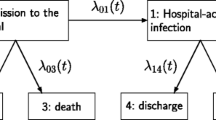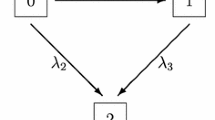Abstract
Inhomogeneous Markov chains are a relevant framework for analysing event histories. The fundamental estimator in the presence of incompletely observed data is the Nelson-Aalen estimator of the multivariate cumulative hazards. It may be summarised in terms of probability estimates via the empirical transition matrix. The empirical transition matrix has only slowly entered applications, one reason being previous lack of software. In a number of applications, further summary measures are desired. We illustrate how they may be computed from the empirical transition matrix and why bootstrapping their variance works. In contrast, computing such summaries outside the present framework has typically led to biased results. As an example, we consider in more detail hospital stay following infectious complication. This summary quantity is often considered by clinical decision makers, but reliable estimates require modelling the timing of infection as in the present set-up. In this context, we also derive new summary measures that further distinguish between patients discharged and patients deceased.
Similar content being viewed by others
References
Aalen O, Johansen S (1978) An empirical transition matrix for non-homogeneous Markov chains based on censored observations. Scand J Stat 5: 141–150
Aalen O, Borgan Ø, Gjessing H (2008) Event history analysis. Springer, New York
Akritas MG (1986) Bootstrapping the Kaplan-Meier estimator. J Am Stat Assoc 81: 1032–1038
Allignol A, Beyersmann J, Schumacher M (2008) mvna: an R package for the Nelson-Aalen estimator in multistate models. R News 8(2):48–50, http://cran.r-project.org/doc/Rnews/Rnews_2008-2.pdf
Allignol A, Schumacher M, Beyersmann J (2010a) Empirical transition matrix of multistate models: the etm package. J Stat Softw (To appear)
Allignol A, Schumacher M, Beyersmann J (2010b) A note on variance estimation of the Aalen-Johansen estimator of the cumulative incidence function in competing risks, with a view towards left-truncated data. Biom J 52: 126–137
Andersen P, Keiding N (2002) Multi-state models for event history analysis. Stat Methods Med Res 11(2): 91–115
Andersen P, Klein J, Rosthøj S (2003) Generalised linear models for correlated pseudo-observations with applications to multi-state models. Biometrika 90(1): 15–27
Andersen PK (1986) Time-dependent covariates and Markov processes. In: Moolgavkar SH, Prentice RL (eds) Modern statistical methods in chronic disease epidemiology. Wiley, NY, pp 82–103
Andersen PK, Borgan Ø, Gill RD, Keiding N (1993) Statistical models based on counting processes. Springer series in statistics. Springer, New York
Anderson J, Cain K, Gelber R (1983) Analysis of survival by tumor response. J Clin Oncol 1: 710–719
Anderson JR, Cain KC, Gelber RD (2008) Analysis of survival by tumor response and other comparisons of time-to-event by outcome variables. J Clin Oncol 26(24): 3913–3915
Benichou J (2001) A review of adjusted estimators of attributable risk. Stat Methods Med Res 10(3): 195–216
Beyersmann J (2007) A random time interval approach for analysing the impact of a possible intermediate event on a terminal event. Biom J 49(5): 742–749
Beyersmann J, Schumacher M (2008) A note on nonparametric quantile inference for competing risks and more complex multistate models. Biometrika 95: 1006–1008
Beyersmann J, Gastmeier P, Grundmann H, Bärwolff S, Geffers C, Behnke M, Rüden H, Schumacher M (2006a) Use of multistate models to assess prolongation of intensive care unit stay due to nosocomial infection. Infect Control Hosp Epidemiol 27: 493–499
Beyersmann J, Gerds T, Schumacher M (2006) Letter to the editor: comment on ‘Illustrating the impact of a time-varying covariate with an extended Kaplan-Meier estimator’ by Steven Snapinn, Qi Jiang, and Boris Iglewicz in the November 2005 issue of the American Statistician. Am Stat 60(30): 295–296
Beyersmann J, Dettenkofer M, Bertz H, Schumacher M (2007) A competing risks analysis of bloodstream infection after stem-cell transplantation using subdistribution hazards and cause-specific hazards. Stat Med 26(30): 5360–5369
Beyersmann J, Gastmeier P, Grundmann H, Bärwolff S, Geffers C, Behnke M, Rüden H, Schumacher M (2008a) Transmission associated nosocomial infections: prolongation of intensive care unit stay and risk factor analysis using multistate models. Am J Infect Control 36: 98–103
Beyersmann J, Wolkewitz M, Schumacher M (2008b) The impact of time-dependent bias in proportional hazards modelling. Stat Med 27: 6439–6454
Beyersmann J, Kneib T, Schumacher M, Gastmeier P (2009a) Nosocomial infection, length of stay and time-dependent bias. Infect Control Hosp Epidemiol 30(3): 273–276
Beyersmann J, Latouche A, Buchholz A, Schumacher M (2009b) Simulating competing risks data in survival analysis. Stat Med 28: 956–971
Billingsley P (1968) Convergence of probability measures. Wiley series in probability and statistics. Wiley, Chichester
Braun TM, Yuan Z (2007) Comparing the small sample performance of several variance estimators under competing risks. Stat Med 26(5): 1170–1180
Cortese G, Andersen P (2010) Competing risks and time-dependent Covariates. Biom J 52: 138–158
Datta S, Satten GA (2001) Validity of the Aalen-Johansen estimators of stage occupation probabilities and Nelson-Aalen estimators of integrated transition hazards for non-Markov models. Stat Probab Lett 55(4): 403–411
Davison A, Hinkley D (1997) Bootstrap methods and their application. Cambridge series in statistical and probabilistic mathematics. Cambridge University Press, Cambridge
Di Serio C (1997) The protective impact of a covariate on competing failures with an example from a bone marrow transplantation study. Lifetime Data Anal 3(2): 99–122
Dudek A, Goćwin M, Leśkow J (2008) Simultaneous confidence bands for the integrated hazard function. Comput Stat 23(1): 41–62
Efron B (1981) Censored data and the bootstrap. J Am Stat Assoc 76(374): 312–319
Fine J, Gray RJ (1999) A proportional hazards model for the subdistribution of a competing risk. J Am Stat Assoc 94(446): 496–509
Gill RD (1983) Large sample behaviour of the product-limit estimator on the whole line. Ann Stat 11: 49–58
Gill RD (1989) Non- and semi-parametric maximum likelihood estimators and the von Mises method. I. Scand J Stat 16(2): 97–128
Gill RD, Johansen S (1990) A survey of product-integration with a view towards application in survival analysis. Ann Stat 18(4): 1501–1555
Glidden D (2002) Robust inference for event probabilities with non-Markov data. Biometrics 58: 361–368
Graves N (2004) Economics and preventing hospital-acquired infection. Emerg Infect Dis 10: 561–566
Gunnes N, Borgan O, Aalen OO (2007) Estimating stage occupation probabilities in non-Markov models. Lifetime Data Anal 13(2): 211–240
Keiding N, Gill RD (1990) Random truncation models and Markov processes. Ann Stat 18: 582–602
Kijima M (1997) Markov processes for stochastic modeling. Chapman & Hall, London
Klein J, Keiding N, Shu Y, Szydlo R, Goldman J (2000) Summary curves for patients transplanted for chronic myeloid leukaemia salvaged by a donor lymphocyte infusion: the current leukaemia-free survival curve. Br J Haematol 20: 1871–1885
Lau B, Cole SR, Gange SJ (2009) Competing risk regression models for epidemiologic data. Am J Epidemiol 170(2): 244–256. doi:10.1093/aje/kwp107
Makuch RW (1982) Adjusted survival curve estimation using covariates. J Chronic Dis 35(6): 437–443
Meira-Machado L, de Uña-Álvarez J, Cadarso-Suárez C (2006) Nonparametric estimation of transition probabilities in a non-Markov illness-death model. Lifetime Data Anal 12(3): 325–344
Peng L, Fine J (2007) Nonparametric quantile inference with competing-risks data. Biometrika 94(3): 735–744
Pepe MS, Mori M (1993) Kaplan-Meier, marginal or conditional probability curves in summarizing competing risks failure time data?. Stat Med 12: 737–751
R Development Core Team (2009) R: a language and environment for statistical computing. R Foundation for statistical computing, Vienna, Austria, http://www.R-project.org, ISBN 3-900051-07-0
Samore M, Harbarth S (2004) A methodologically focused review of the literature in hospital epidemiology and infection control., 3rd edn, Lippincott Williams & Wilkins, Philadelphia, chap 93, pp 1645–1656
Scheike TH, Zhang MJ (2007) Direct modelling of regression effects for transition probabilities in multistate models. Scand J Stat 34(1): 17–32
Schulgen G, Schumacher M (1996) Estimation of prolongation of hospital stay attributable to nosocomial infections. Lifetime Data Anal 2: 219–240
Schumacher M, Wangler M, Wolkewitz M, Beyersmann J (2007) Attributable mortality due to nosocomial infections: a simple and useful application of multistate models. Methods Info Med 46: 595–600
Southern DA, Faris PD, Brant R, Galbraith PD, Norris CM, Knudtson ML, Ghali WA (2006) Kaplan- Meier methods yielded misleading results in competing risk scenarios. J Clin Epidemiol 59(10): 1110–1114
van der Vaart A, Wellner JA (1996) Weak convergence and empirical processes. With applications to statistics. Springer series in statistics. Springer, New York
Van Houwelingen H (2007) Dynamic prediction by landmarking in event history analysis. Scand J Stat 34(1): 70–85
van Walraven C, Davis D, Forster A, Wells G (2004) Time-dependent bias was common in survival analyses published in leading clinical journals. J Clin Epidemiol 57: 672–682
Wangler M, Beyersmann J, Schumacher M (2006) changelos: an R-package for change in length of hospital stay based on the Aalen-Johansen estimator. R News 6(2):31–35, http://CRAN.R-project.org/doc/Rnews/
Author information
Authors and Affiliations
Corresponding author
Additional information
Supported by Deutsche Forschungsgemeinschaft (FOR 534).
Rights and permissions
About this article
Cite this article
Allignol, A., Schumacher, M. & Beyersmann, J. Estimating summary functionals in multistate models with an application to hospital infection data. Comput Stat 26, 181–197 (2011). https://doi.org/10.1007/s00180-010-0200-x
Received:
Accepted:
Published:
Issue Date:
DOI: https://doi.org/10.1007/s00180-010-0200-x




